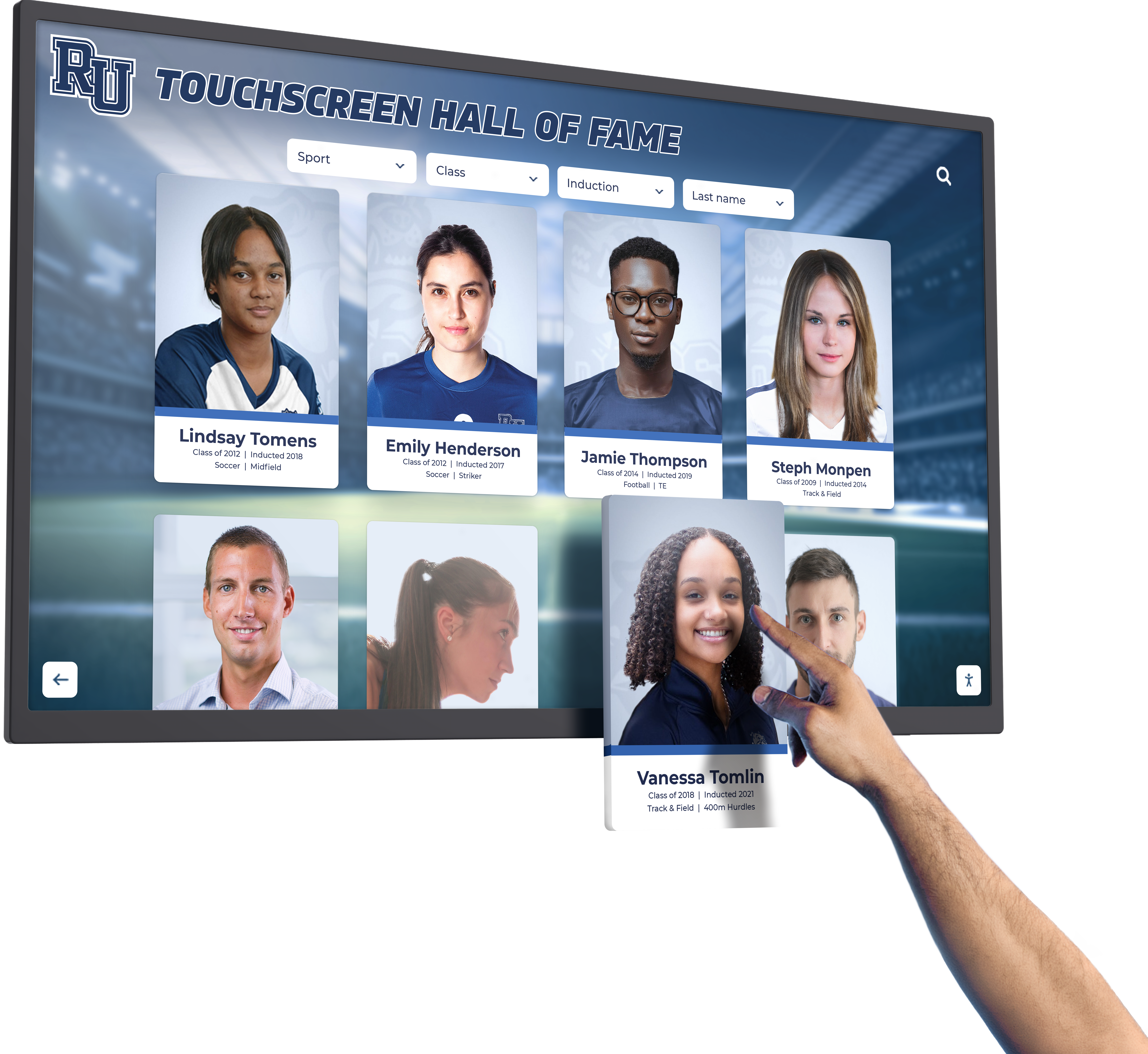Walk into any school built in the last century, and you’ll likely find trophy cases lining the hallways—glass-fronted cabinets filled with championship trophies, plaques, and fading photographs. These traditional displays have served schools well, but they share a critical limitation: they run out of space. As achievements accumulate and programs expand, schools face an impossible choice about which accomplishments deserve recognition and which must be relegated to storage rooms.
This shift from physical to digital recognition represents more than technological adoption—it reflects changing expectations about how information should be accessed, how stories should be told, and how communities should connect with institutional history. Understanding why schools are making this transition helps explain broader trends in how educational institutions approach recognition, engagement, and community building.
The Space Problem: Why Traditional Displays Fail
Traditional trophy cases worked perfectly when schools had fewer programs, smaller student populations, and decades of accumulated achievements that could fit in available display space. But as schools expanded athletic programs, added academic competitions, recognized diverse achievements, and accumulated century-long histories, physical space became the primary constraint limiting recognition programs.
The Inevitable Capacity Crisis
Most schools discover their space limitations follow predictable patterns. Initially, new trophy cases accommodate growing collections comfortably. Athletic directors arrange trophies attractively with adequate space between items. Every championship receives prominent placement.

Within five to ten years, cases fill completely. Staff begin removing older trophies to make room for recent achievements. Items crowd together. Identification labels shrink to fit available space. Eventually, most trophies never make it to display cases at all—they’re photographed briefly, stored in offices or closets, and gradually forgotten.
This progression creates difficult decisions. Should state championships from thirty years ago be removed to showcase last week’s conference title? Do recent achievements automatically take priority over historical significance? These zero-sum choices undermine recognition programs by suggesting some accomplishments matter more than others.
Hidden Collections and Forgotten Achievements
Schools accumulating decades of trophies, plaques, and recognition items often discover significant collections hidden in storage. Athletic directors maintain office shelves filled with trophies that never fit in cases. Administrators store boxes of awards in closets. Coaches keep team photos and memorabilia in locked cabinets.
These hidden collections represent legitimate achievements and dedicated effort, but they provide no recognition value when stored away from public view. Athletes who earned championships, students who won academic competitions, and teams who achieved excellence see their accomplishments acknowledged briefly during awards ceremonies, then effectively forgotten as physical items disappear into storage.
The problem extends beyond athletics. Academic achievements, arts recognitions, service awards, and leadership honors all compete for limited display space. Schools emphasizing comprehensive recognition across diverse excellence categories quickly exhaust physical capacity for traditional displays.
The Maintenance Burden
Traditional trophy cases also create ongoing maintenance requirements that many schools struggle to manage effectively. Glass surfaces require regular cleaning. Locks break and need replacement. Lighting systems fail. Physical rearrangement to add new items or remove old ones requires unlocking cases, carefully moving fragile items, creating new identification labels, and reassembling displays.
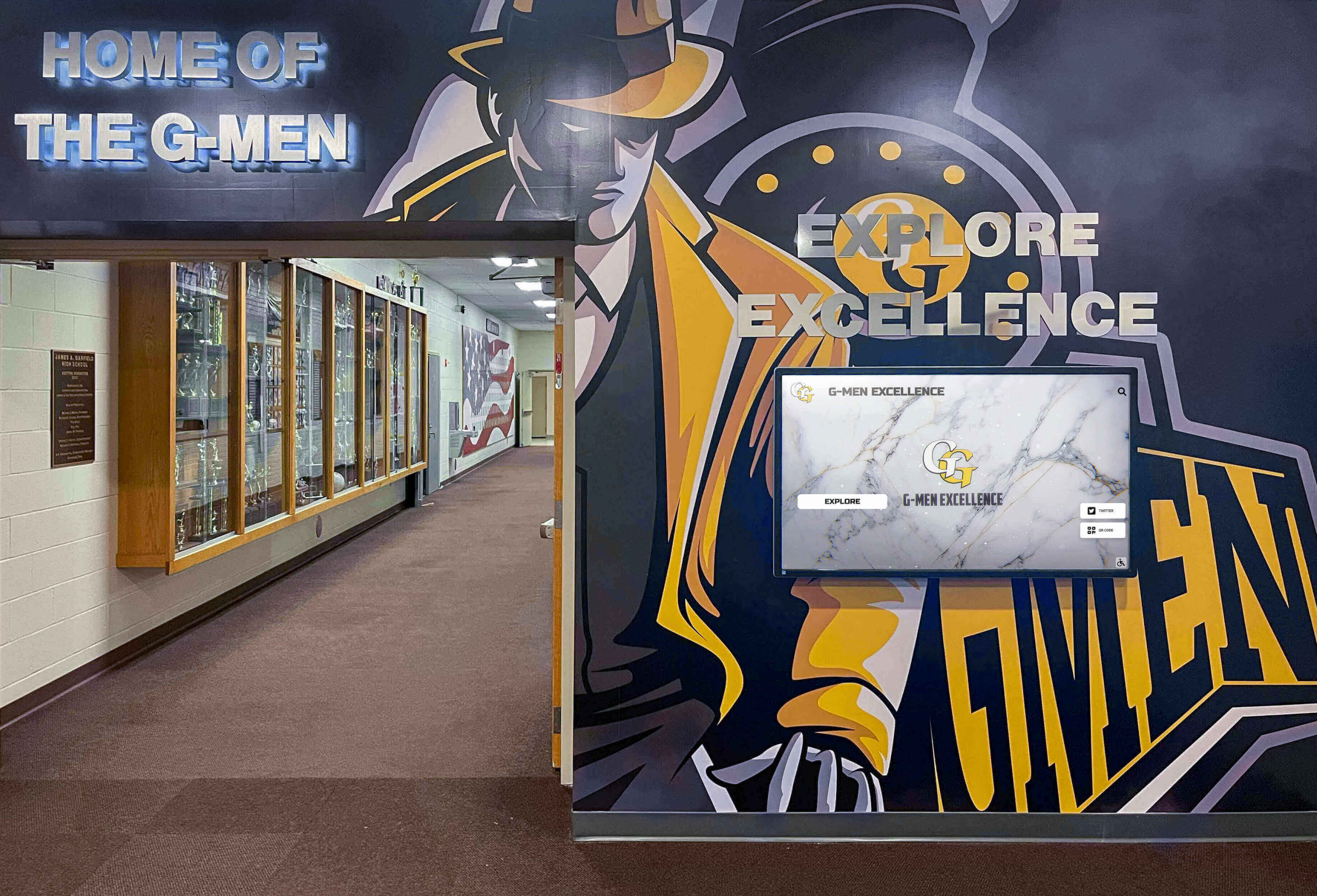
These maintenance demands often get deferred because they’re time-consuming and inconvenient. The result: trophy cases that look neglected, with dusty glass, burned-out lights, and overcrowded arrangements that diminish rather than enhance the recognition they’re meant to provide.
Athletic directors and administrators recognize these problems but often lack practical alternatives. Purchasing additional trophy cases provides only temporary relief—new cases fill quickly and simply postpone inevitable capacity limits. This cycle explains why schools increasingly explore digital solutions that eliminate space constraints entirely.
Understanding Digital Wall of Fame Technology
Digital wall of fame displays replace or supplement traditional trophy cases with interactive touchscreen systems that showcase achievements through digital media. Rather than physical trophies behind glass, schools create comprehensive digital profiles featuring high-resolution photos, detailed narratives, video content, and searchable databases accessible through intuitive touch interfaces.
Core Components and Infrastructure
Modern digital wall of fame systems consist of several integrated components working together to create seamless recognition experiences:
Commercial-Grade Touchscreen Displays: The visible centerpiece of any digital wall of fame installation is a commercial touchscreen display, typically ranging from 43 to 75 inches diagonal. These displays use capacitive touch technology similar to tablets but are specifically engineered for continuous public operation. Unlike consumer televisions, commercial displays handle 16-18 hours of daily use and feature enhanced brightness (400-700 nits) ensuring visibility in well-lit school environments.
Size selection depends primarily on viewing distance and location characteristics. Hallway installations where viewers stand 6-12 feet away work well with 55-65 inch screens. Main lobby locations in larger spaces benefit from 70-75 inch displays readable from greater distances. Smaller spaces like athletic offices can accommodate 43-50 inch displays that still deliver engaging experiences.
Content Management Software: Purpose-built platforms enable non-technical staff to create, organize, and update digital content without specialized training. Cloud-based architectures allow authorized users to manage content from any internet-connected device—office computers, home laptops, or smartphones.
This flexibility proves particularly valuable for athletic directors who can photograph new trophies with phones and upload them immediately rather than waiting until they have physical access to trophy cases. Template-based content creation ensures consistent professional appearance across all entries, while powerful search and filtering capabilities transform static displays into interactive research tools.

Mounting and Installation Options: Schools can choose from several installation approaches based on architectural constraints and aesthetic preferences. Wall-mounted displays create clean, modern appearances and preserve floor space. Freestanding kiosk enclosures offer placement flexibility and can accommodate specific accessibility requirements. Custom installations integrate displays into architectural features or existing recognition wall designs.
How Digital Displays Transform Recognition
The shift from physical to digital recognition creates qualitative differences in how achievements are documented, accessed, and experienced:
Unlimited Recognition Capacity: Digital storage eliminates physical space constraints entirely. A single 55-inch touchscreen can showcase thousands of individual profiles, team photos, achievement categories, and historical content that would require 20-30 traditional trophy cases to display physically. This unlimited capacity changes recognition strategy fundamentally—instead of choosing which achievements deserve limited space, schools can document everything comprehensively.
Rich Multimedia Storytelling: Physical trophies communicate limited information—typically just engraved names, dates, and brief achievement descriptions. Digital recognition displays expand these narratives dramatically through multiple media formats that create emotional connections and provide meaningful context.
High-resolution photo galleries document trophies, team photos, action shots from competitions, and celebration moments. Video content brings championships to life through game highlights, performance recordings, and interview segments. Detailed written narratives provide comprehensive achievement context impossible to include on physical plaque labels. This multimedia depth transforms recognition from simple acknowledgment into inspiring storytelling that engages viewers and preserves institutional memory richly.
Interactive Exploration and Search: Traditional trophy cases offer passive viewing—visitors glance briefly while passing. Interactive digital displays create active exploration that holds attention and enables personalized discovery. Touchscreen search functions let alumni find every trophy and team photo they appeared in instantly. Parents can locate their children’s achievements across multiple sports and years. Current students can research specific records or explore athletes they’ve heard about from coaches.
This search capability creates personal connections that increase engagement substantially. Schools consistently report visitors spending 5-10 minutes exploring interactive displays compared to 30-60 seconds glancing at traditional cases. Extended interaction time translates to deeper appreciation and stronger emotional connections with recognition content.
Why Schools Are Making the Switch: Key Drivers
Multiple factors converge to drive schools’ adoption of digital wall of fame displays. Understanding these motivations helps explain why digital recognition continues gaining momentum across educational institutions.
Solving the Space Crisis
The most obvious driver is solving the space limitations that plague traditional trophy case programs. Schools with extensive achievement histories and active programs simply run out of physical space to display everything that merits recognition. Digital systems eliminate this constraint completely, allowing comprehensive documentation of all achievements regardless of quantity.
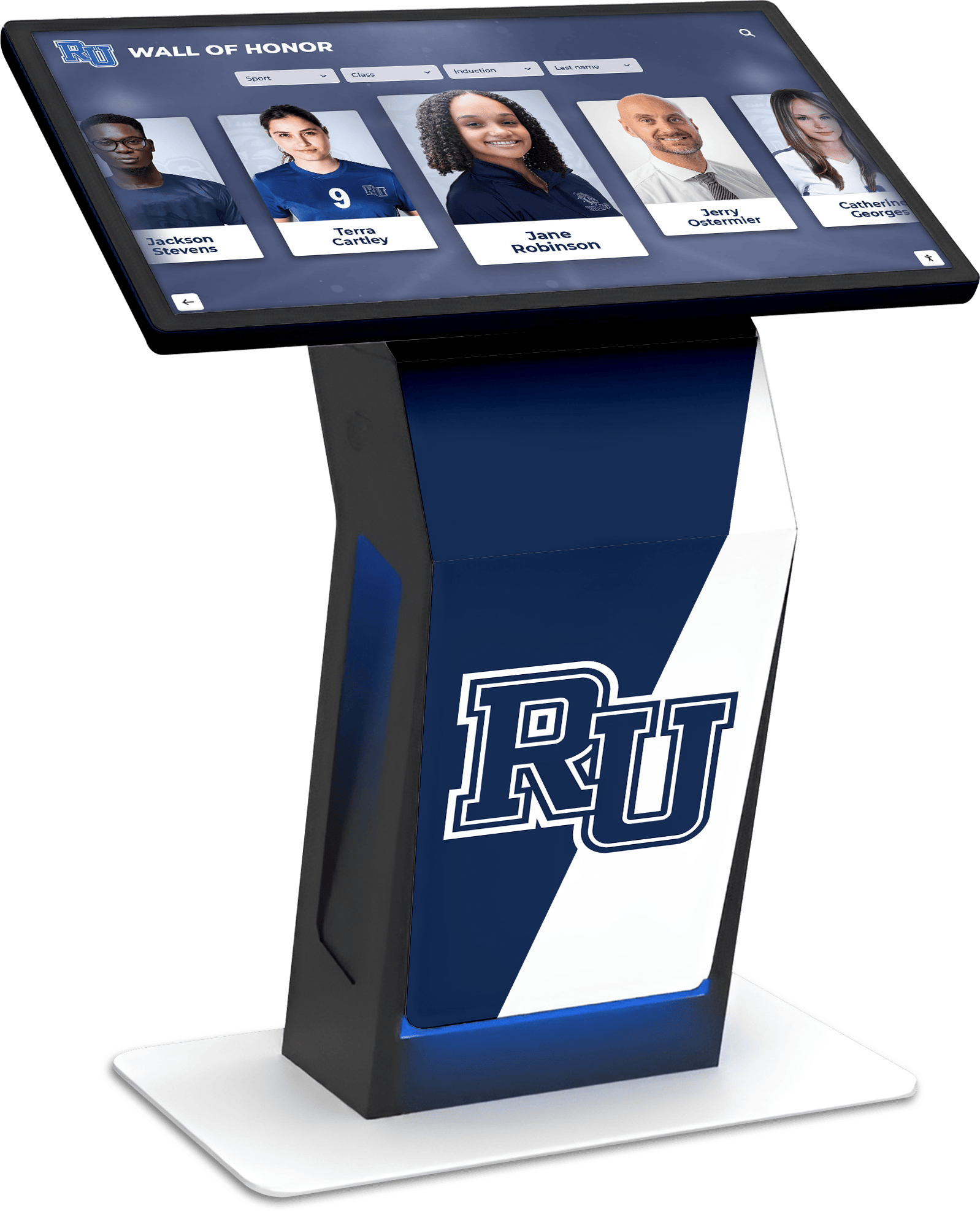
This unlimited capacity proves particularly valuable for schools committed to recognizing diverse forms of excellence. Programs celebrating academic achievements, arts accomplishments, service contributions, and leadership recognition alongside athletic success generate extensive content that quickly overwhelms traditional display capacity. Digital platforms accommodate all categories equitably without space-driven prioritization.
Engaging Digital-Native Students
Current students have grown up interacting with touchscreens, searching digital content, and accessing information through interactive interfaces. Traditional trophy cases feel static and outdated to generations accustomed to dynamic, searchable, multimedia content experiences. Digital wall of fame displays align with how students naturally interact with information, making recognition content more accessible and engaging for current populations.
This alignment matters for recognition program effectiveness. If displays feel irrelevant or inaccessible to current students, they fail to inspire or connect regardless of content quality. Interactive digital recognition creates experiences that resonate with how students already consume content, increasing likelihood they’ll actually engage with achievement histories and see themselves reflected in institutional excellence.
Supporting Recruitment and Marketing
Schools increasingly recognize that recognition displays serve recruiting functions by showcasing program excellence to prospective students and families. Traditional trophy cases provide limited information to visitors evaluating programs. Digital displays enable comprehensive demonstration of:
- Championship histories showing program success over time
- Individual achievement records documenting development opportunities
- College commitment tracking showing athletic and academic pathways
- Alumni success stories demonstrating long-term educational value
- Program philosophy content explaining coaching approaches and culture
This comprehensive information helps prospective families make informed decisions while positioning schools competitively in recruiting situations. When prospects can explore decades of achievements, search for specific information, and see detailed documentation of excellence, they form clearer impressions of program quality than traditional displays enable.
Operational Efficiency and Cost Management
While digital systems require larger upfront investments than basic trophy cases, comprehensive cost analysis often reveals favorable long-term economics. Schools avoid recurring expenses including new trophy case purchases as collections grow ($2,000-$5,000 per case), physical trophy and plaque production for items that never fit in display spaces, professional installation labor for case modifications ($100-$300 per update), and ongoing physical maintenance requirements.
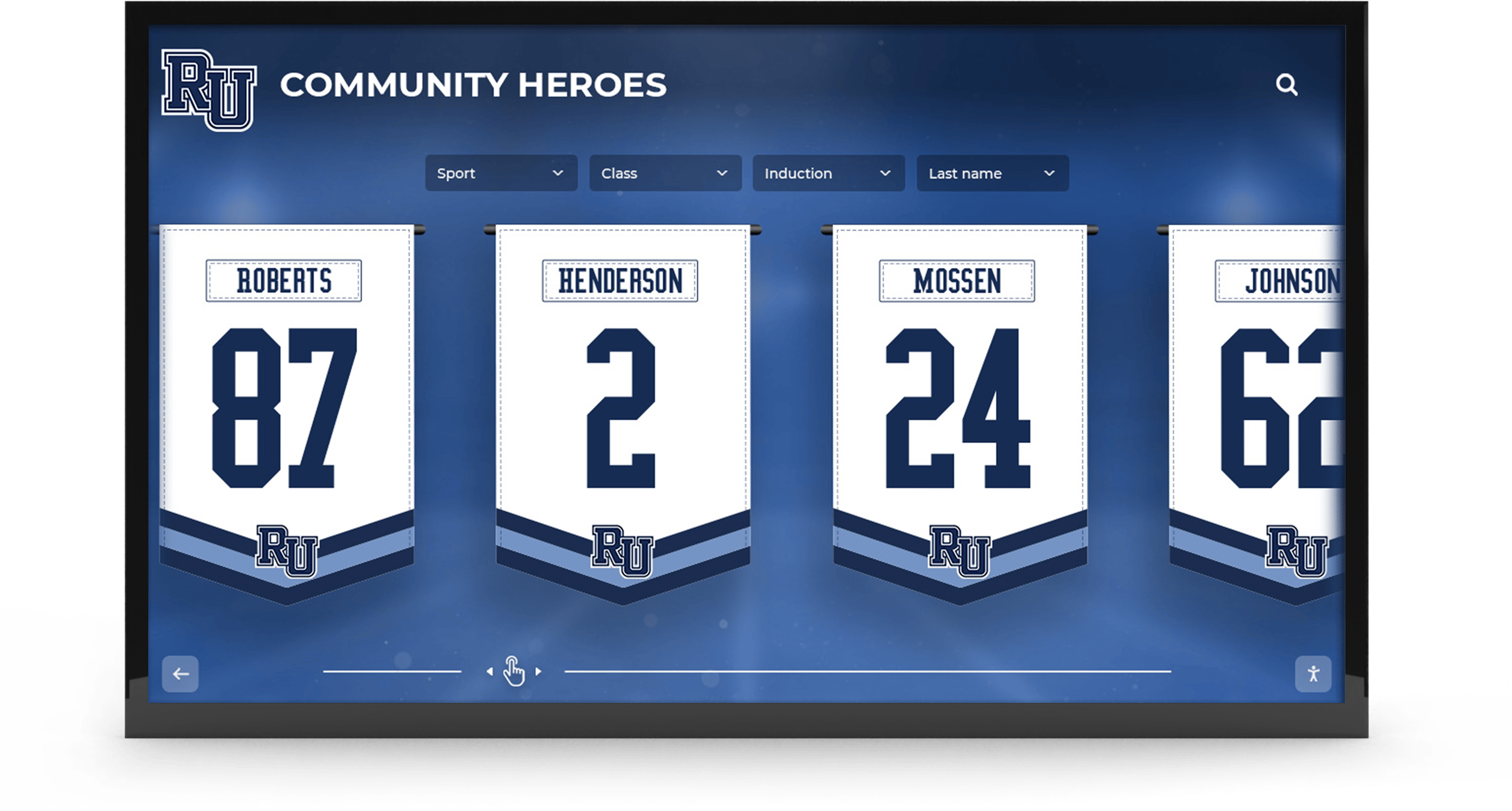
Content updates that require hours with traditional cases—unlocking, physically rearranging trophies, creating new labels, reassembling displays—take minutes with digital systems. Athletic directors photograph trophies with smartphones, log into cloud-based management systems, create entries using templates, and publish updates instantly. This dramatic time savings accumulates significantly across multiple sports and achievement types throughout each year.
Maintenance requirements also decrease substantially. Physical trophy cases need glass cleaning, lock repairs, lighting replacement, and damage repairs. Digital displays require minimal maintenance—primarily periodic screen cleaning comparable to maintaining computer monitors—that custodial staff handle without specialized expertise or significant time investment.
Strengthening Alumni Connections
Digital recognition systems create stronger alumni engagement through several mechanisms that traditional displays can’t match. Online accessibility allows alumni to explore recognition content from anywhere rather than requiring campus visits. Search functionality enables quick location of personal achievements across years and categories. Shareable digital content facilitates social media distribution that extends recognition reach beyond physical campuses.
Many schools find that alumni regularly access digital recognition platforms remotely, exploring their own achievements, looking up former teammates, and staying connected to institutional history. This ongoing engagement supports advancement efforts by maintaining relationships and demonstrating that achievements remain valued decades after graduation. The return on investment from improved alumni engagement often justifies digital recognition investments independently of other benefits.
Preserving Institutional Memory
Physical trophies deteriorate over time—metal tarnishes, engraving fades, components break. Photos stored in albums or traditional frames fade and become fragile. Important achievements risk being forgotten as physical artifacts age and documentation becomes lost or damaged. Digital documentation provides more durable institutional memory preservation through cloud-based storage with automatic backup systems that protect against loss.
High-resolution photography captures trophy details permanently. Written narratives document achievement context and significance for future generations. Video content preserves personal stories and experiences in ways that physical items alone cannot convey. This comprehensive digital preservation ensures that today’s achievements remain accessible and meaningful decades into the future.
Implementation Realities: What Schools Need to Know
Schools considering digital wall of fame displays naturally focus on practical implementation questions. Understanding costs, timelines, and requirements helps set realistic expectations and enables informed decision-making.
Real-World Investment Analysis
Complete digital wall of fame systems typically cost $8,000-$25,000 for initial implementation including hardware, software, installation, and initial content development. This range reflects differences in display sizes, mounting configurations, software feature sets, and content development approaches.
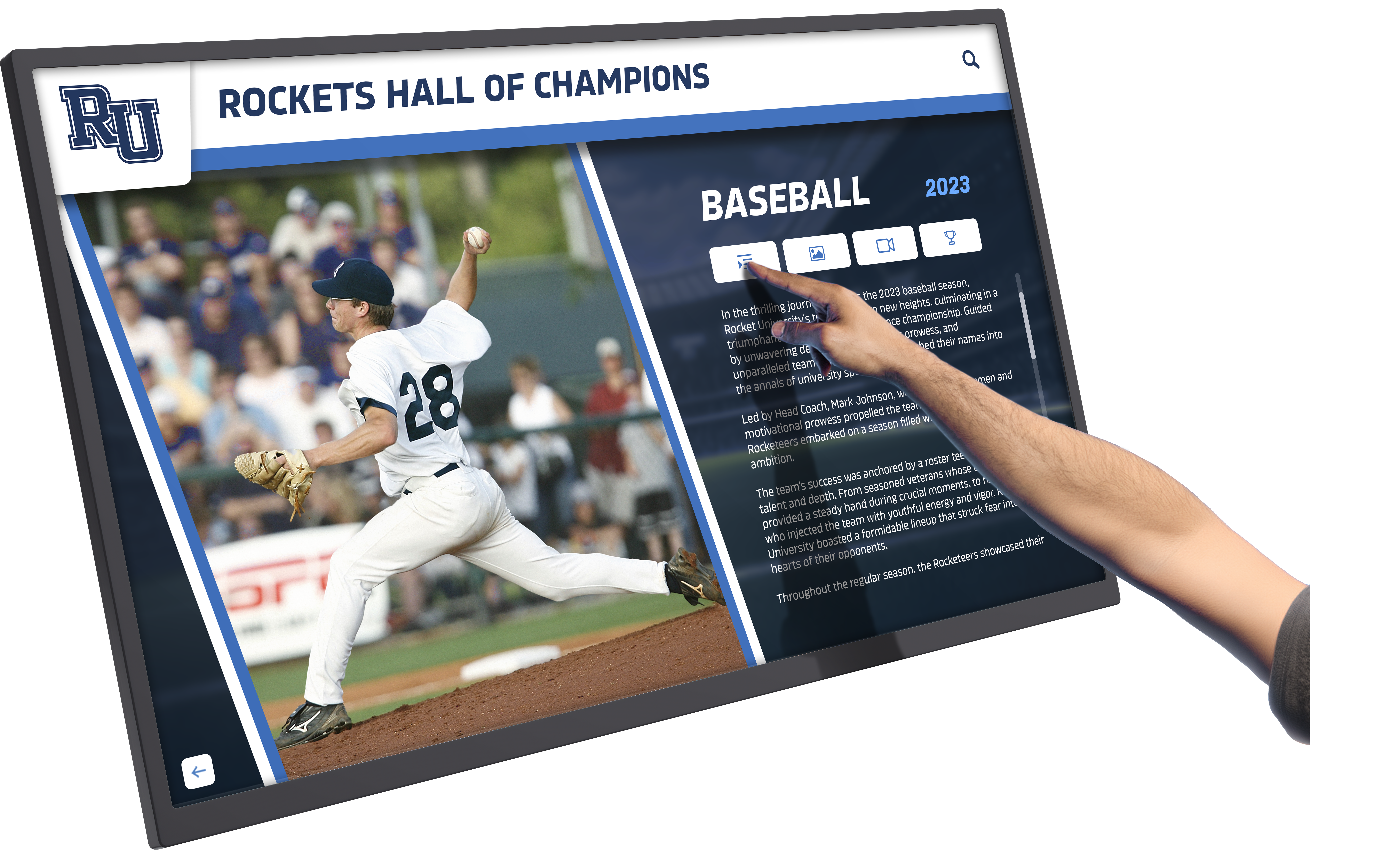
Hardware Costs: Commercial touchscreen displays range from $2,500-$7,000 depending on size and specifications. Mounting hardware or kiosk enclosures add $300-$2,500 based on configuration complexity. Media player computers cost $400-$800, and professional installation labor typically runs $500-$2,000 depending on location requirements and existing infrastructure.
Software and Services: Platform licensing costs $1,200-$5,000 annually depending on features, number of displays, and support levels included. Initial content development—professional photography, data entry, and system configuration—ranges from $2,000-$8,000 based on collection size and whether schools use professional services or handle work internally.
Long-term Operational Costs: Annual ongoing expenses typically total $1,500-$6,000 covering software licensing ($1,200-$5,000), electricity ($30-$60 per display), and minimal maintenance supplies. Content updates beyond initial setup require staff time but minimal additional costs—typically 1-3 hours monthly depending on how frequently new achievements are added.
When accounting for avoided costs over 10-15 year timeframes—additional trophy case purchases, ongoing physical trophy production, installation labor, and maintenance expenses—digital systems often prove cost-competitive with traditional approaches while providing vastly superior recognition capacity and engagement.
Implementation Timeline Expectations
Typical implementations span 8-16 weeks from initial planning to public launch, though timelines vary based on project scope and school-specific factors:
Planning Phase (2-4 weeks): Initial planning establishes objectives, defines content scope, selects technology, and develops budgets. Schools involve stakeholders including athletic directors, administrators, technology staff, and facilities managers to ensure implementations address diverse requirements and perspectives.
Hardware Procurement (2-3 weeks): Once technology selections are finalized, hardware ordering and delivery typically requires 2-3 weeks. Custom kiosk enclosures or specialized mounting solutions may extend this timeline. Schools can use this period to work on content development, effectively overlapping activities to compress overall timelines.
Content Development (3-6 weeks): Initial content creation represents the most variable timeline component. Schools with organized achievement records and quality photography can compress content development. Those requiring extensive historical research, trophy photography, and data entry need more time. Many schools implement phased content development—launching with priority content and expanding comprehensively over subsequent months.
Installation and Configuration (1-2 weeks): Physical installation, network configuration, software setup, and staff training typically require 1-2 weeks. This phase includes testing all functionality, ensuring content displays correctly, and confirming staff members can perform routine content management tasks confidently.
Schools with urgent timelines can sometimes compress implementations to 6-8 weeks by working intensively on content development during hardware procurement periods and accepting phased content expansion rather than comprehensive initial documentation.
Technology Requirements and Infrastructure
Digital wall of fame systems require modest infrastructure that most schools already have or can implement easily:
Network Connectivity: Displays need reliable internet access for content updates and remote management. Wired Ethernet connections provide the most reliable connectivity and are preferred when available. WiFi works well when signal strength is strong at display locations. Some systems include cellular backup ensuring displays remain operational during network outages.
Content is typically cached locally on display computers, allowing continued operation even when internet connectivity is temporarily unavailable. Viewers can still explore all content, search achievements, and interact normally—only content updates require active network connections.
Power Infrastructure: Standard 120V electrical outlets provide sufficient capacity for displays and computing hardware. Total power consumption runs 150-250 watts during operation—comparable to desktop computers. Consider surge protection or uninterruptible power supplies (UPS) to protect equipment from power quality issues, though these aren’t strictly required for basic functionality.
Physical Space Requirements: Wall-mounted displays need 8-10 feet of clear viewing space in front of screens to prevent traffic flow obstruction. For accessibility compliance, position displays with screen centers at 48-52 inches for comfortable use by visitors of varying heights, including wheelchair users. Freestanding kiosks provide more flexible placement and often better accommodate accessibility requirements through adjustable height configurations.
Content Management Reality Check
Schools sometimes worry that digital systems will require significant ongoing staff time or technical expertise. Experience shows that effective content management becomes routine operation integrated into existing workflows rather than creating substantial additional burdens:
Initial Learning Curve: Staff members need 2-4 hours of initial training to become comfortable with content management interfaces. Modern platforms feature intuitive designs requiring no technical expertise—if staff can use email and social media, they can manage digital recognition content. After initial training, most staff feel confident handling routine content updates independently.
Ongoing Time Commitment: Adding new championship trophies takes 15-20 minutes per entry including photographing the trophy, uploading images, entering achievement details, and publishing. Monthly content reviews and featured content updates require 1-2 hours. These requirements prove substantially less burdensome than traditional trophy case maintenance involving physical access, unlocking, rearrangement, and installation work that often gets deferred because of time requirements.
Quality Standards and Consistency: Successful schools establish content standards covering photography specifications (resolution, lighting, backgrounds), text content structure, naming conventions, and metadata requirements. These standards guide initial development and ongoing additions, maintaining quality as content responsibilities transition among staff members over time. Template-based content creation systems help enforce consistency automatically without requiring staff to remember complex guidelines.
Best Practices for Digital Wall of Fame Success
Schools achieving the greatest value from digital wall of fame investments follow proven approaches that ensure sustained relevance and engagement over time.
Strategic Placement and Installation
Location determines visibility and usage frequency. The best digital wall of fame installations occupy high-traffic areas where students, staff, visitors, and alumni naturally congregate:

Ideal Locations: Main entrance lobbies create powerful first impressions and serve the broadest audience including prospective families during recruitment visits. Athletic facilities like gymnasiums and field houses position recognition where current athletes see it daily, providing regular inspiration and context for program traditions. Cafeterias and commons areas capture high student traffic during natural downtime when students might explore displays. Hallways connecting popular destinations ensure regular exposure though typically shorter interaction periods.
Avoid isolated locations regardless of available wall space. Perfectly designed displays deliver minimal impact if visitors never encounter them. Consider traffic patterns, sight lines, and natural gathering points when selecting locations. Schools often identify optimal placement by observing where students naturally congregate during passing periods and breaks.
Accessibility Considerations: Position displays at heights accommodating all visitors. Screen centers at 48-52 inches allow comfortable use by both standing viewers and wheelchair users. Ensure 8-10 feet of clear floor space in front of displays prevents congestion and allows multiple simultaneous users. When installing in hallways, verify sufficient width remains for normal traffic flow alongside groups viewing displays.
Content Strategy That Engages
Digital platforms enable extensive content, but effective installations balance comprehensiveness with focused curation that guides exploration without overwhelming visitors:
Organizational Frameworks: Structure content using clear categorization that matches how visitors think about achievements. Primary organization typically follows sport or activity categories since this aligns with how most people mentally organize achievements. Within categories, chronological organization helps users explore historical development while achievement-type filtering (conference championships, state titles, individual records) provides alternative navigation paths.
Feature current content prominently while ensuring historical achievements remain discoverable. Home screens might highlight recent additions, current season progress, or upcoming events before visitors explore comprehensive archives. This balance maintains currency while preserving complete historical documentation.
Quality Standards: Establish and maintain photography standards ensuring consistent professional appearance. High-resolution images (minimum 1920x1080 for featured content), consistent lighting, neutral backgrounds, and clean trophy presentation create polished experiences. Written content should follow consistent structures, use appropriate terminology, and provide sufficient detail without becoming excessively verbose.
These standards guide both initial content development and ongoing additions, preventing quality degradation as content responsibilities transition among staff over time. Template-based creation systems help enforce standards automatically while allowing flexibility for different content types.
Keeping Content Fresh and Relevant
Digital displays remain engaging through consistent content updates and seasonal rotations that maintain visitor interest:
Update Schedules: Publish new championships within 24-48 hours of achievement. This responsiveness demonstrates that digital recognition provides timely acknowledgment rather than delayed commemoration. Feature currently active sports prominently through seasonal rotations—highlight basketball during basketball season, shift to track and field during spring. Regular historical spotlights keep older content circulating rather than becoming invisible within large databases.
Schedule annual comprehensive reviews ensuring all information remains accurate, photos meet quality standards, and organizational structures serve user needs effectively. These reviews prevent incremental quality degradation that occurs when small issues accumulate unaddressed over time.
Community Contributions: Invite alumni to submit photos, stories, and updates about historical achievements. Create simple web-based submission processes allowing community members to contribute content for review and potential inclusion. This crowdsourcing often reveals historical materials that official records lack while building ownership and engagement within alumni communities.
Engage current students in content development through journalism classes researching achievement profiles, photography courses documenting trophy collections, or history classes exploring institutional athletic traditions. Student involvement provides educational opportunities while ensuring content resonates with current student perspectives.
Measuring Success and Iterating
Use available analytics to understand engagement patterns and make data-informed improvements:
Quantitative Metrics: Track which sports and content types receive most views, what search terms visitors use frequently, how long typical interactions last, what times see peak usage, and which navigation paths users follow most commonly. These insights guide content organization refinements, feature content selections, and strategic decisions about additional display locations or content expansion priorities.
Qualitative Feedback: Supplement analytics with stakeholder feedback. Survey students, alumni, and visitors about their experiences. Document stories about how recognition inspired or connected people. Assess whether displays accomplish stated objectives around recognition comprehensiveness, engagement quality, and operational efficiency.
Regular assessment enables continuous improvement and helps justify continued investment in recognition programs by demonstrating measurable value across multiple dimensions.
The Future of Digital Recognition in Education
Digital wall of fame technology continues evolving with emerging capabilities that will further enhance recognition effectiveness and accessibility:
Emerging Technology Trends
Artificial Intelligence Integration: AI capabilities will enable more sophisticated content management and personalized experiences. Automated content creation tools may generate achievement narratives from structured data, suggest related content connections, and automatically tag new entries based on learned patterns. Natural language search interfaces accepting conversational queries like “Show me all basketball championships from the 1990s” will make comprehensive collections more accessible.
Personalized recognition showing individual viewers content relevant to their connections, history, or expressed interests may create more engaging experiences, though schools must balance personalization benefits against privacy considerations and equitable access principles.

Augmented Reality Features: AR technology may extend digital recognition beyond screens. Visitors could point smartphones at showcase physical trophies to see overlaid digital content—video highlights from championship games, detailed statistics, or athlete interviews. Virtual trophy rooms viewable anywhere might allow alumni to explore complete collections remotely with immersive three-dimensional presentations that recreate physical space experiences digitally.
Enhanced Accessibility: Continued focus on universal design will improve access for visitors with disabilities. Screen reader compatibility, voice navigation options, adjustable text sizes, high-contrast display modes, and multilingual content will ensure recognition programs serve entire school communities equitably. Inclusive digital recognition design principles will become standard expectations rather than optional enhancements.
Evolving Recognition Practices
Beyond technology advances, schools are reconsidering what and how they recognize:
Broader Excellence Definitions: Recognition programs increasingly honor diverse achievement forms beyond traditional athletics and academics. Service leadership, community impact, creative accomplishment, character demonstration, and peer recognition complement conventional achievement categories. Digital platforms accommodate this expansion naturally through flexible organizational structures and unlimited capacity.
Collective Achievements: While individual recognition remains important, schools increasingly celebrate team accomplishments, class achievements, and group contributions that demonstrate collaborative excellence. Digital storytelling enables rich documentation of team dynamics, seasonal development, and collective success in ways that individual trophy recognition alone cannot capture.
Real-Time Recognition: Rather than only commemorating completed achievements at season ends, some schools implement real-time recognition tracking current season progress, highlighting weekly accomplishments, and celebrating incremental success alongside championship victories. This ongoing recognition maintains visibility and relevance throughout seasons rather than concentrating attention on final outcomes exclusively.
Making the Transition: Practical Next Steps
Schools ready to explore digital wall of fame displays benefit from systematic approaches that address both practical requirements and strategic considerations:
Assessment and Planning
Begin by thoroughly understanding current situations and defining clear objectives. Document existing trophy collections through inventories identifying what’s displayed, stored, or located in various offices and athletic spaces. This assessment reveals content scope for digitization and highlights achievements currently lacking recognition due to space constraints.
Engage stakeholders early including athletic directors, coaches, administrators, technology staff, and facilities managers. Their diverse perspectives surface requirements, concerns, and opportunities that individual viewpoints might miss. Build support through involvement rather than presenting completed plans that stakeholders had no opportunity to shape.
Define specific goals beyond “solve space problems.” Consider whether objectives include providing comprehensive recognition for all programs, creating engaging experiences that inspire current students, preserving institutional memory, supporting recruiting efforts, or strengthening alumni connections. Clear goals guide subsequent decisions about technology, content priorities, and success measurement approaches.
Technology Selection Considerations
Match technology choices to specific needs rather than automatically selecting most expensive or feature-rich options:
Display Size: Select sizes appropriate for viewing distances and space characteristics. Oversized displays in small spaces overwhelm, while undersized displays in large areas lack impact. Visit existing installations when possible to see actual displays in similar environments before finalizing specifications.
Mounting Approach: Choose configurations matching architectural constraints and accessibility requirements. Wall mounting preserves floor space and creates clean installations but requires suitable wall structures. Freestanding kiosks offer placement flexibility and often better accommodate accessible height requirements through adjustable configurations.
Software Platforms: Purpose-built recognition platforms like Rocket Alumni Solutions offer significant advantages over generic digital signage software or custom development. Specialized platforms include pre-designed templates optimized for recognition content, intuitive management interfaces requiring no technical expertise, built-in search and navigation features, and ongoing updates without additional development costs. Generic alternatives may have lower initial licensing but typically require more implementation effort and ongoing technical maintenance.
Content Development Approaches
Quality content determines digital wall of fame effectiveness regardless of hardware excellence. Consider multiple development approaches:
Professional Services: Some schools hire professional photographers and data entry services for initial comprehensive content creation. This approach ensures consistent quality and compresses timelines but requires larger upfront budget allocation. It works well for schools with limited internal resources or urgent implementation deadlines.
Internal Development: Athletic department staff, student workers, or volunteer alumni can handle content development internally. This approach reduces costs and builds internal ownership but requires more time and ongoing quality oversight. It suits schools with available staff capacity and less urgent timelines.
Phased Implementation: Rather than attempting complete collection documentation before launching, many schools implement incrementally. Phase 1 might focus on recent championships (past 5-10 years) and currently active programs. Phase 2 expands to comprehensive coverage of all programs. Phase 3 adds historical content systematically. This approach enables earlier launches demonstrating value while distributing content development work across manageable timeframes.
Conclusion: Embracing Digital Recognition’s Future
The rise of digital wall of fame displays reflects broader technological adoption trends while addressing specific recognition challenges that schools with successful programs inevitably face. Traditional trophy cases served well for decades, but accumulated achievements and expanding programs ultimately overwhelm physical space limitations that glass cabinets cannot solve.
Digital recognition systems eliminate space constraints entirely while transforming achievement documentation from simple trophy display into rich multimedia storytelling that engages viewers, preserves institutional memory comprehensively, and creates accessible discovery experiences impossible with physical displays. This transformation matters because recognition programs serve multiple purposes—honoring achievement, inspiring current students, engaging alumni, supporting recruitment, and preserving history—that interactive digital platforms advance more effectively than traditional approaches.
Schools making this transition typically proceed thoughtfully, implementing strategically rather than rushing to adopt technology for its own sake. Successful implementations follow systematic planning, engage diverse stakeholders, prioritize content quality, and maintain ongoing commitment to keeping recognition programs fresh and relevant. The technology enables transformation, but sustained value requires operational commitment to managing content, maintaining quality, and continuously improving based on usage patterns and stakeholder feedback.
For schools still relying exclusively on traditional trophy cases, the question increasingly becomes not whether to adopt digital recognition but when and how to implement thoughtfully. The benefits—unlimited capacity, enhanced engagement, operational efficiency, improved alumni connections, and superior institutional memory preservation—create compelling value propositions that justify investment even when existing trophy case arrangements remain adequate for current needs.
The future of school recognition is clearly digital. Schools embracing interactive displays today position themselves effectively for tomorrow’s increasingly tech-savvy students, alumni, and families who expect institutional information to be searchable, multimedia-rich, and accessible through intuitive interfaces. By understanding why schools are making this switch and learning from implementations already delivering strong results, educational institutions can approach digital recognition adoption confidently, ensuring that every achievement receives the comprehensive, lasting recognition it deserves.
Ready to explore how digital wall of fame displays can transform your school’s recognition program? Solutions like Rocket Alumni Solutions provide comprehensive platforms specifically designed for educational institutions seeking to modernize recognition while honoring tradition and creating engaging experiences that serve entire school communities effectively.
